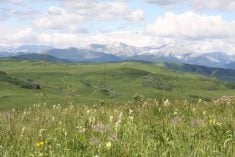Sandbagging, sandbag volunteers and diking were prominently featured in the media coverage of this year’s 2½ month spring flood in Manitoba.
Doug Chorney felt sorry for the flood victims, but the media coverage on the number of sandbags available to fight the flood drove him up the wall.
“I get frustrated when I hear municipal politicians bragging about how many sandbags have been filled,” said Chorney, president of Keystone Agricultural Producers.
“When really it is solving no problem. It’s treating the symptoms of a bigger problem.”
Read Also

Selenium not deal breaker in coal mining: expert
Environmental scientist weighs in on coal mining debates in Western Canada, explaining selenium and the technologies and practices to lower its concentrations in nearby waterways to coal mining operations
Instead of spending money on sandbag machines, dike construction and compensation for soaked fields, Chorney would like the Manitoba government to spend more on flood prevention. Specifically, he wants the province to compensate farmers who preserve the wetlands on their land.
Ideally, Chorney would like the province to adopt a policy used in the Rural Municipality of Dufferin, near Carman, Man.
The RM and the LaSalle Redboine Conservation District pay $40 per acre to farmers who are willing to preserve their sloughs.
Fred Dunn, a municipal councillor in Dufferin who helped develop the compensation program, said the payment doesn’t add up to much because it covers only wetland acres.
However, the financial incentive does put a value on sloughs and recognizes a farmer’s contribution to the environment, he said last year.
Adopting such a policy across Manitoba would cost millions of dollars, but Chorney said the government is already spending hundreds of millions on flood mitigation and flood response.
“We hear reports that the province and the federal government may be (paying out) $500 million in compensation for overland flooding this year because of excess moisture,” he said.
“The money is being taken out of the public purse regardless…. Why don’t we start investing in strategies that are going to solve the problems?”
Chorney and other KAP representatives have met with provincial officials and conservation groups over the last couple of years to discuss developing an ecological goods and services program in Manitoba.
He said the time may be right for political leaders to get behind a wetlands compensation program, considering this spring’s flooding.
Tim Sopuck, chief executive officer of Manitoba Habitat Heritage Corp., said most people agree that wetlands provide ecological services, such as holding back excess water and storing nutrients.
However, instituting a policy that would pay farmers to preserve wetlands is complicated, he added. Should all farmers who maintain wetlands be compensated or should all landowners be required to meet minimal environmental requirements and the government pay only farmers who exceed the standard?
“(If ) Producer A has protected enough wetlands to achieved his, you might call it his environmental responsibility, at what point should we be providing an incentive to go beyond that?” asked Sopuck, brother of Dauphin-Swan River MP Robert Sopuck.
“I don’t think that’s been well defined and it’s a tough question.”
Another sticking point is that some environmental groups don’t support the concept of financial rewards for ethical behaviour. Instead, they believe the government should compel landowners to act in a way that benefits rivers, streams and the environment.















